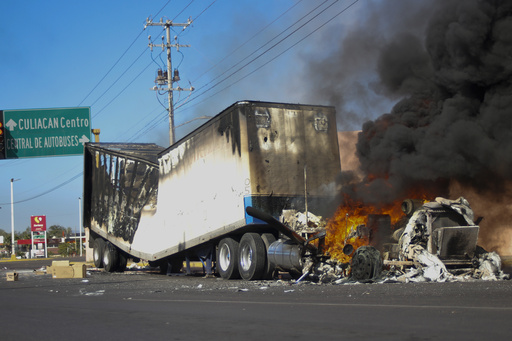
U.S. Designates Eight Latin American Crime Groups as Foreign Terrorist Organizations
In a significant move, the U.S. government has officially classified eight organized crime syndicates from Latin America, which are also active within the U.S., as “foreign terrorist organizations.” These groups are deeply implicated in drug trafficking, migrant smuggling, and exert territorial control often through violent means.
This classification stems from the Trump administration’s effort to deploy a “terrorist” label typically associated with groups like Islamic State or al-Qaida, intended for organizations that commit violence for political purposes. In this case, however, the U.S. is targeting crime-ridden entities more concerned with profit than ideology. The official announcement is set to be included in the Federal Register on Thursday, following a statement made on Wednesday.
Below is a summary of the eight Latin American cartels now recognized as foreign terrorist groups:
Sinaloa Cartel – Mexico
The Sinaloa Cartel, a long-established criminal organization in Mexico, has been active since the 1970s. It operates as a vast conglomerate, presiding over various factions from its base in the mountainous regions of the northwestern state of Sinaloa. The cartel maintains significant control over the western section of the U.S.-Mexico border.
This organization is notorious for trafficking an array of drugs across international borders, utilizing boats, aircraft, migrants, and even sophisticated cross-border tunnels. The cartel is implicated in widespread corruption, with a former security official found guilty of collaborating with them.
Recently, Sinaloa’s involvement in producing fentanyl, a synthetic opioid responsible for countless overdose fatalities in the U.S., has come under scrutiny. The cartel sources precursor chemicals from China, manufactures the drug, and smuggles it into the U.S. The apprehension of longtime leader Ismael “El Mayo” Zambada in July has spurred an intense power struggle within the organization as loyalists vie for dominance against the sons of Joaquín “El Chapo” Guzmán, currently imprisoned.
Jalisco New Generation Cartel – Mexico
The Jalisco New Generation Cartel, which initially gained notoriety after a gruesome incident in 2011 involving dismembered bodies, is recognized for its extreme violence and rapid territorial expansion through alliances with local gangs. Based in Jalisco, this cartel actively confronts authorities, using tactics that include assaults on military helicopters and even drone attacks.
Under the leadership of Nemesio “El Mencho” Oseguera, the U.S. Drug Enforcement Administration alleges that Jalisco is responsible for distributing massive quantities of cocaine, methamphetamine, and fentanyl across all 50 states.
Gulf Cartel and Northeast Cartel – Mexico
Operating primarily along the eastern U.S.-Mexico border, the Gulf and Northeast Cartels are heavily involved in drug trafficking, migrant smuggling, arms dealing, and money laundering, representing the most direct trafficking route originating from Central and South America.
The Gulf Cartel has a storied history with a notorious past, but recent fragmentation has led to internal strife among competing factions. The former leader, Osiel Cárdenas Guillén, had previously enlisted members of the Mexican military, resulting in the formation of the Zetas, which later became an independent criminal organization.
The Northeast Cartel is an offshoot of the Zetas and has maintained control over a fraction of the territory previously dominated through brutal methods. Nuevo Laredo, a key commercial hub at the border, serves as their stronghold.
La Nueva Familia Michoacana and United Cartels – Mexico
These regional crime syndicates, located in west-central Mexico, are involved in the production of synthetic drugs and pose a significant threat to U.S. interests, particularly concerning the avocado industry. With Michoacan exporting avocados worth $2.8 billion, local criminal elements have put this lucrative trade under threat.
According to security expert David Saucedo, U.S. inspectors working in Michoacan have faced intimidation from these gangs, who dominate avocado production and manipulate market prices through extortion and threats against farmers.
Tren de Aragua – Venezuela
Emerging from Venezuelan prisons more than a decade ago, Tren de Aragua has expanded its operations from Chile to the U.S., exploiting the flight of millions of Venezuelans fleeing severe political and economic instability. While initially rooted in drug trafficking, this group’s primary activities now encompass migrant smuggling, human trafficking, and sexual exploitation.
Their notoriety for extreme violence, including decapitations and live burials, instills fear throughout various regions. U.S. officials contend that Tren de Aragua has infiltrated South American criminal networks, utilizing cryptocurrency for money laundering, presenting a growing threat in numerous U.S. cities.
Mara Salvatrucha – El Salvador
Known as MS-13, this gang emerged in Los Angeles during the 1980s, primarily formed by Salvadoran refugees escaping civil war. Over the years, MS-13 has become synonymous with extreme violence and urban drug sales in the U.S., later spreading to El Salvador where it gained significant control over territories and regularly extorted local residents.
However, since President Nayib Bukele initiated a crackdown on gang activities nearly three years ago, resulting in over 80,000 arrests, the gang has faced severe setbacks, though civil rights organizations have raised concerns about the methods employed in these operations.

